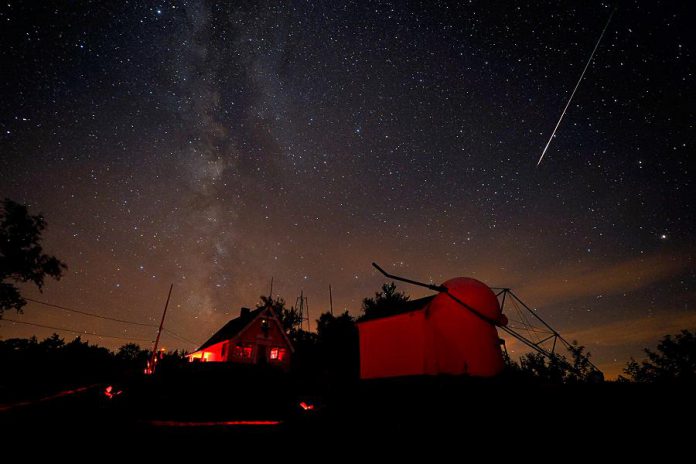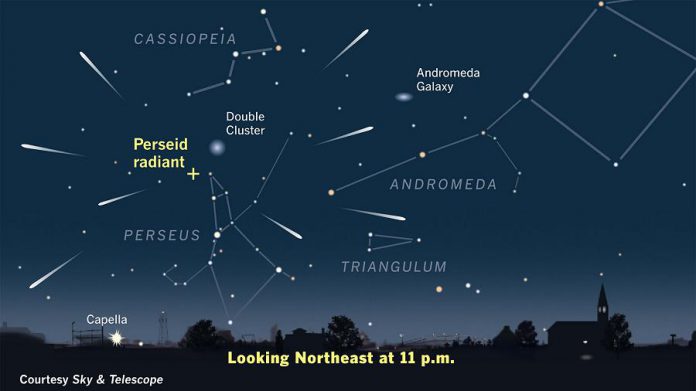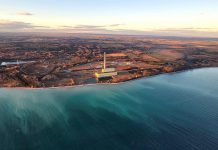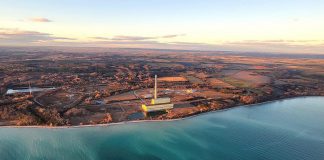
The Perseid meteor shower is an annual celestial event loved by stargazers in the Northern Hemisphere — and a moonless sky this year makes for ideal conditions to see the natural light show.
The meteor show will peak overnight on Sunday, August 12th and into early Monday morning. The prime viewing hours will be from around 11 p.m. on Sunday night until the first light of dawn.
The weather forecast for Sunday night is looking good for meteor viewing, although there may be cloudy periods. However, because there’s a new moon on August 11th, there will be no bright moonlight to hinder the view.
“The moonless sky this year means the viewing will be excellent,” says Diana Hannikaine, Observing Editor with Sky & Telescope magazine. “Under a very dark sky, you might see up to one Perseid per minute late on Sunday night or after midnight on Monday morning.”

“The Perseids will put on a great show,” adds Senior Editor J. Kelly Beatty. “Relax, be patient, and let your eyes adapt to the darkness.”
While you wait for the flash of a Perseid in the sky, you can imagine how your distant ancestors probably did the very same thing — NASA says the Perseids have presented a dazzling display for 2,000 years.
The Perseid meteor shower begins every year in late July, peaking in mid August, as the Earth plows through the interplanetary debris left behind by comet Swift-Tuttle when it passed close to Earth (the last time was in 1992, and the next time will be in 2126).
When the particles of debris left behind by the comet — which can be as small as a grain of sand or as big as a pea — slam into the Earth’s atmosphere at around 210,000 kilometres per hour, they heat up to 1,650 degrees Celsius and are vapourized in a burst of heat and light, resulting in a “shooting star.”

It’s called the Perseid meteor shower because the meteors appear to originate from the northeast sky in the direction of the constellation of Perseus.
If the weather permits, the Peterborough Astronomical Association will host a viewing on top of Armour Hill at Asburnham Memorial Park beginning at 8:30 p.m. on Sunday, August 12th (association members will also have telescopes set up to view Jupiter, Saturn, Mars, and more).
The event is free and open to the public, with parking available in the lower lot opposite the Peterborough Museum and Archives (for safety reasons, Armour Hill itself will be closed to vehicles). Note that if the skies are too cloudy or if it’s raining, the event will be cancelled.
If conditions are poor for viewing the meteor shower in person, you can always watch it online. Online observatory Slooh.com will be hosting a special broadcast on YouTube starting at 5 p.m. on Sunday, August 12th. The eight hour broadcast will begin with Slooh’s astronomers taking questions posted with the hashtag #Slooh and discussing the history and the science of the Perseid meteor shower.
If you miss the meteors this weekend, the shower will continue until late August, although the meteors won’t be as frequent.
Tips for viewing the Perseid meteor shower
- Find the darkest place you can, away from any light pollution, with as much open sky as possible. Rural areas away from city lights with few buildings or trees are the best. If you can’t get away from your city, find a park or golf course.
- Lie on your back and take in as much of the night sky as possible. You don’t have to face Perseus (to the northeast) to see the meteor shower, but the more sky you can see, the better your chances.
- Be prepared to stay outside for at least an hour. It takes 20-30 minutes for your eyes to adjust to the darkness, and the meteors come in spurts and lulls; so the longer you wait, the more you’ll see. If the outburst happens as expected, there’ll be an average of two to three meteors per minute. Some of these will be faint and some will be bright streaks.
- Stay awake. The Perseid meteors are typically best between midnight and dawn, with the hours before dawn being the best time.
If you are interested in taking photos of the meteor shower, check out these tips from Sky & Telescope.


























